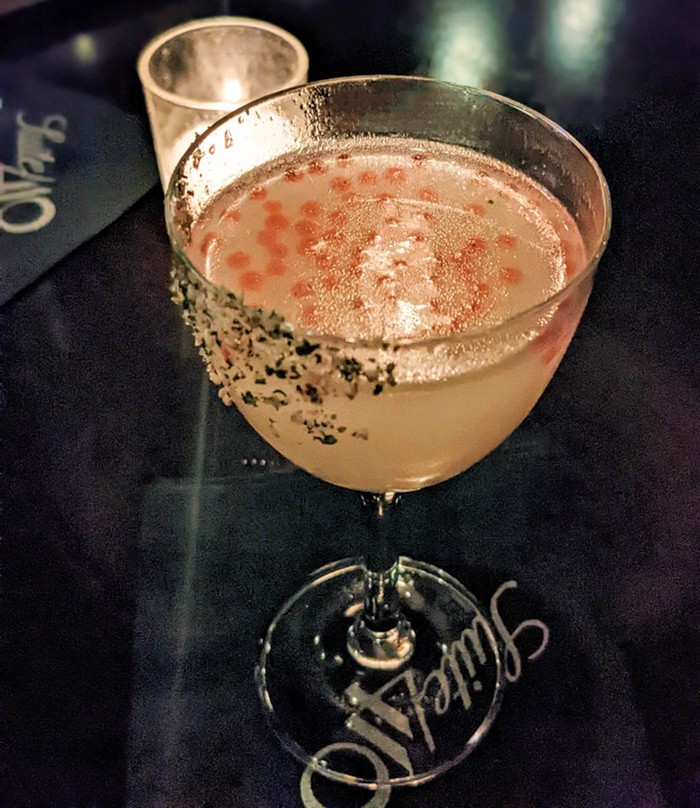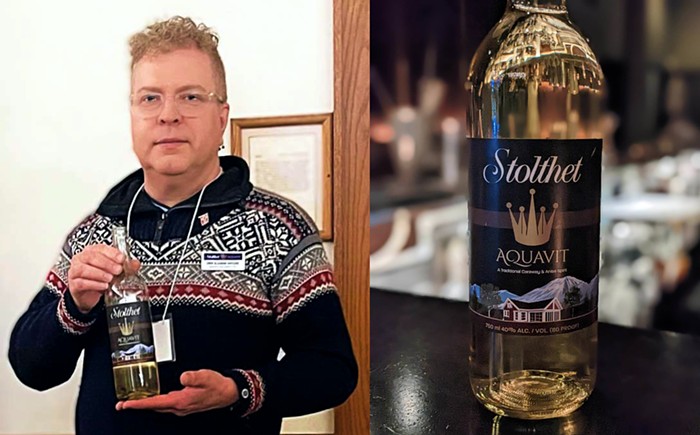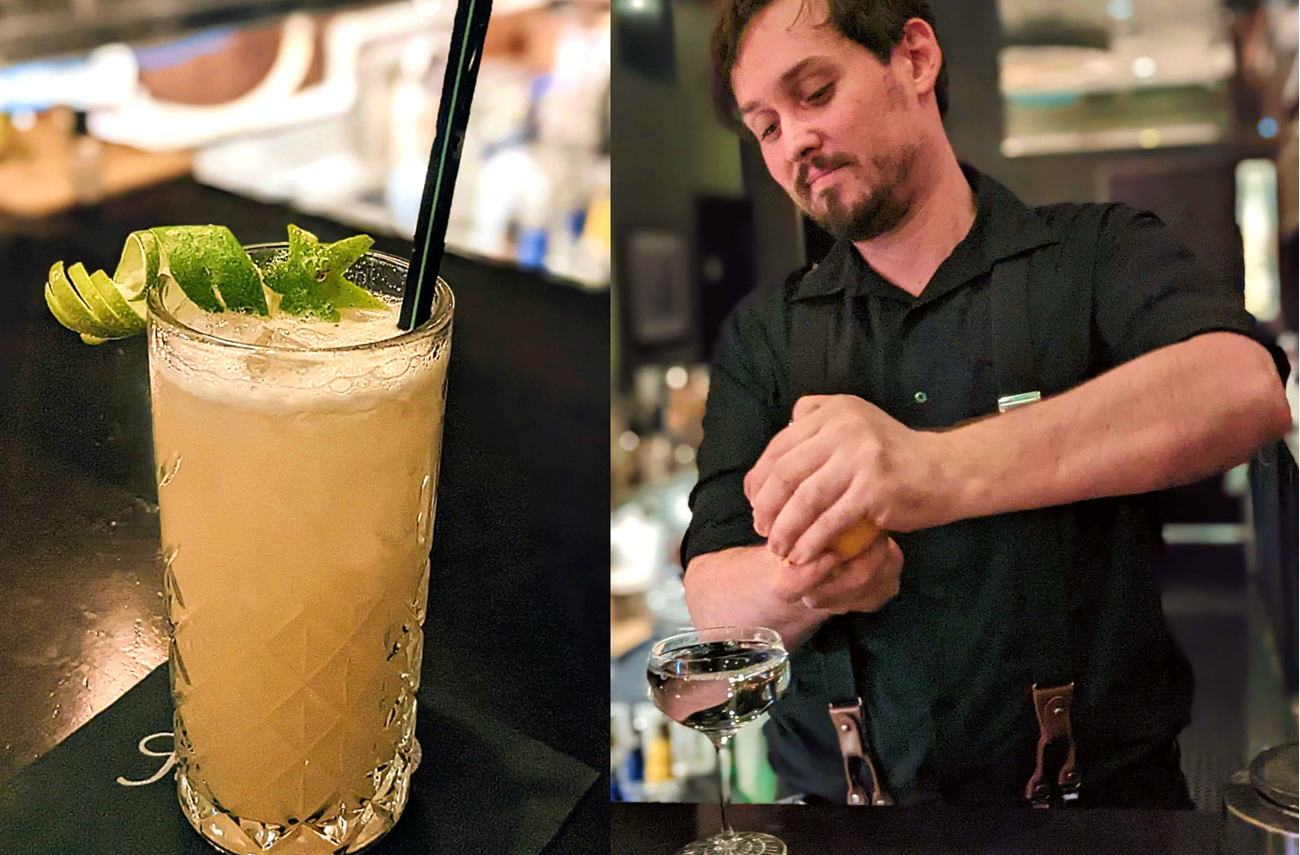This cocktail is a story in two parts, as it’s a mashup between two bright Seattle stars, but I’m gonna tell it backwards. Let’s begin at the end, at Suite 410 at Fourth Avenue and Stewart, a downtown cocktail lounge that’s been lately enjoying a renaissance.
I went to a couple of office happy hours here in about 2014, and that’s all it’s ever been to me until a few weeks ago. We had French 75s and Manhattans in an austere lounge full of chrome and black leather, and it was fine. Trendy hotel bar energy with a menu full of safe standards and a couple lightweight craft cocktails. So, when I saw Suite 410 popping up on some best-of lists lately, I was like “...The French 75 place??”
Turns out, it’s because Benjamin Wright is at the helm now.
Benjamin’s is a pretty fresh face in town. He moved to Seattle almost two years ago with his wife, Taylor, who tends bar nearby at Oliver’s Lounge in the Mayflower Park Hotel. They come to us from Northern California’s wine country, most recently Santa Rosa, although Benjamin has lived all over, including an extended stay in China while studying for a master’s in fine art. You can see he’s a character straight away, in suspenders with leather button fasteners, with a deck of tarot cards stacked next to the well. It doesn’t take long for him to ask me to pull a card.
“My grandma did this for a living,” he says as he fans the cards out. “She was a Cuban woman living in Sonoma County who didn’t speak any English, and she did readings for fellow Spanish-speaking women in the area. Although she told me that boys can’t be witches because boys can’t create life, so I might not be the best at it!” When I pull The Sun, he claps his hands. “Hell yeah! Optimism and positivity!”

I already like this guy, but I like him even more when I see his cocktail list, whose reputation had preceded him. The menu’s immediate standout is the Kobayashi Maru, with the bolded, underlined warning: “If it’s your first time here, we highly recommend trying something else first.” It’s a blend of vodka and rye, accented by germinated toasted rice syrup, “alcoholic caviar” made from hibiscus and more vodka, and a furikake rim. The name’s a nod to a training test in the Star Trek films, wherein a Starfleet Academy cadet must make an ethical decision whether to rescue or abandon a ship by the same name, not realizing it’s a no-win scenario.
“That one is my pet,” Benjamin says, “and it’s really popular because of the name. I named it this because it’s not what it seems! It’s not the sum of its ingredients—a whole new thing is created when they’re combined—and what the ingredients turn into isn’t always something that people like. But people come in here and are like ‘Oh, my God! Star Trek reference! Gotta have it!’ and then send it back half the time, so I had to add the disclaimer. I’m super proud of this one, though.”
Tempting, and I eventually did try it—it’s good! Kinda weird! Kinda like drinking an Orbitz and eating sushi at the same time, and definitely an example of the internet’s proverbial “secret third thing” that I wasn’t expecting from the menu description! But during that first round at the modern incarnation of Suite 410, I sensed that the sleeper hit on the cocktail list was gonna be An Apple a Day Keeps the Caraway. That’s aquavit, barley tea, carbonated cucumber water, malic acid from apples, and Gran Classico. How very weird and riveting at once.
“I like caraway, so I hope it doesn’t keep the caraway away,” I said.
Funny I should ask, Benjamin says. I should let him tell me the story, he says.
“So, I was originally trying to get the chef at Oliver’s [Suite 410’s sister bar, which has the same owners] to make rice cakes but out of barley, which had caraway and green fennel in them. But the first attempt was a failure. We figured it out, but anyway, as a result, we were cooking all these vats of barley! So I figured I gotta find a way to use up all the barley water byproduct somehow.”
And those caraway and fennel flavors are also found in aquavit, of course. So one gets an idea.
“Right! So, first of all, I take pearled barley and a handful of caraway seeds, and I boil it down to make a tea. And to this tea, I add a little sugar to brighten it up. Then, it’s some cucumber water that’s been acid-adjusted with malic acid, which is the acid from apples. Then the malic acid/cucumber water mix is force-carbonated, and it’s floated on top to add acidity and brilliance to the cocktail.”
Seeeeeeeee, this is 100% my shit. How did you come up with MALIC acid? I know it gets added to wine sometimes, but I’ve never heard of anyone using this in a mixed drink.
“Well, we were initially making the drink with fino sherry, which is mellower, so it didn’t detract from the herbal qualities of the aquavit. But this Stolthet Aquavit is heavier on the fennel-anise and has less caraway flavor, so it reads a little like absinthe. So I was trying to lean into a melon note that’s also present in the Stolthet and boost the caraway up, so we needed acid, and fruit acid specifically. If you taste just the plain aquavit, there’s that melon note in front, and then there’s subtle caraway in the back. So the cucumber water helps accent the melon, since a cucumber is a melon, and the malic acid and the Gran Classico help to bring up the caraway flavor! And obviously, the small amount of caraway in the barley tea does as well.”
So it doesn’t keep the caraway away, I say.
“No,” Benjamin says, “because I made it a point to bring the caraway back! And these flavors were all already in the aquavit, of course—my job is just to coax them out. The reverence to the spirit is the first priority.”
Okay, this guy is a giant fucking nerd and I’m charmed. I let him go off on molecular gastronomy as he puts my drink together, and he sets it before me with a flourish.
At first glance, the drink looks sorta like an iced oat milk latte, so it’s a bit of a disconnect when the first note you taste is melon-cucumber. Fruit! That apple acid is distinct and familiar as well, and there’s a rhubarby emotion in there too. But the texture is creamy and silky—despite containing zero dairy products—and it’s thanks to both the starch in the barley tea and also the louche effect. Like all aniseed liquors, which contain anethole, aquavit when diluted with cold water produces a milky effect. You’ve seen this depicted on a thousand illustrated Art Nouveau posters: the mystical swirl in the absinthe glass, turning the clear liquor opaque. It’s the silty river meeting the cold sea, inside your glass, and creating the perfect riparian zone of mouthfeelings. A frooty, boozy, botanical milkshake hiding in a dairy-free iced coffee costume. Once again, on Benjamin’s cocktail list, we meet the secret, more complex third thing.
I did taste the caraway, but it seemed like a normal amount of caraway that you find in aquavit, so I wouldn’t have known that Benjamin went out of his way to punch it back up if he hadn’t told me. It’s not until the third sip or so that I caught the bitter Gran Classico at the end—just a touch of wormwood and gentian, the usual digestif suspects that’re also found in absinthe, which additionally help to bring the caraway beat back.
When I exclaim over the creamy mouthfeel in a staunchly dairy-free cocktail, Benjamin replies, “Yeah, I’m kind of obsessed with making silky drinks right now! It’s a running theme on pretty much every cocktail on my menu right now—I’m really into texture. People who really like the sharp texture of alcohol can struggle with this current cocktail list, because they feel like they don’t have any alcohol content. They taste like they have booze in them, but they just don’t feel like it. You know, you get obsessed with a color sometimes, or a song? For me right now, it’s silk.”
Benjamin, a nerd, aforementioned, even tied the flavors he chose into Scandinavian cuisine, since aquavit. Apples feature heavily in Scando food, and along with wheat and rye, barley is an ancient staple for both animals and people in Arctic European communities. You’ll commonly find cucumbers in Nordic menus too, whether pickled or sliced fresh on open-faced smørrebrød. I accused Benjamin of spending a lot of time thinking about this cocktail, and he was like, “Oh, yeah, it kept me up at night until I figured it out. I’d come in first thing in the morning, many hours before the bar opened, to experiment on this one.”
Should go without saying, but this is a grown folks cocktail and isn’t really for beginners—which is such a departure from the bar that Suite 410 was on my previous visit, I can’t even tell you. Sitting and drinking the AAaDKtC gives you kind of an ancient feeling about yourself. Like you can imagine being in your little sod house on some frozen cliffside in the North Sea like 400 years ago, whiling out the winter on aquavit, and you’re like fuck, I’m sick of drinking the same thing every day. How’re we gonna dress it up today? What we got growing out there? Um, some cucumber and apples… and barley? And some herbs and shit? Man, and the repurposed barley tea is just a stroke of genius here. People would’ve done this.
***

Right: Local aquavit maker Erik-Bjarne Witzøe, repping his brand, Stolthet Aquavit, at the Swedish Club last month. Left: Redmond’s own Stolthet Aquavit is sold at the Ballard Liquor Store, Bob’s Liquors on Lake City Way, the Edmonds QFC, and Redmond Ridge Spirits in Redmond, and Ballard’s Skål Beer Hall. You can also sample it by the shot or the cocktail at Skål Beer Hall, as well as the Cozy Nut Tavern in Greenwood, the top-floor Three Crowns Lounge at the Swedish Cultural Center on Dexter, and, of course, at Suite 410 in downtown Seattle. Erik-Bjarne Witzøe and Meg Van Huygen
This brings me to the second part of the story, which is actually the first: the aquavit itself. Benjamin uses Stolthet Aquavit, produced locally in Redmond. The name translates to “pride” in all the Scandinavian languages, and owner/producer Erik-Bjarne Witzøe chose it carefully when he started the biz in 2017. “It seemed to be a fitting name for me, in the realm of my own personal being,” Erik-Bjarne explains. “Stolthet is the pride of your culture—the pride of who you are in the spectrum of life.”
How does one get the idea to distill their own aquavit here in Seattle, and not in, say, a frozen sod house in rural 17th-century Norway?
“Well, I come from a Norwegian immigrant family. My father was from Kristiansund, Norway, and my mother's parents came from northern Norway.” Erik-Bjarne himself was born in—and lives in—Ballard, which is, of course, ground zero for Seattle’s Norwegian-American community, where it’s impossible to miss all the Scandinavian flags on homes and businesses alike. What’s that, you say a Seattle guy is producing his own aquavit? Obviously, he’s based in Ballard. It writes itself, folks.
“So, yeah, I was inspired by my ancestral land!” Erik-Bjarne says. “Before I was making aquavit, I was designing labels for a brand of vodka called Durwoods, which is made by Sahalee Liquor Company in Redmond. After having a discussion about how to create my own aquavit with a longtime Norwegian friend, the opportunity came up to actually develop an aquavit with Sahalee. I’d approached the owner of Sahalee with the idea of making a reimagined aquavit, aiming to improve on the many traditional aquavits out there.” Stolthet Aquavit was the eventual result, and so naturally, it’s bottled by Sahalee Liquor Company.
To me, Stolthet stands out as being incredibly smooth, among the mainstream aquavits available in the US, and Erik-Bjarne tells me why. “The first step to start with was to work with a smooth grain base. Most aquavits are based on potatoes, which makes the spirit hard to consume due to the burn effect. This is the main reason why aquavit bottles are usually chilled in the freezer.“
I personally did not know this. “Yeah, many aquavits will burn your throat when they’re going down unless they’re chilled.”
But not yours? “Ha ha, nope. Not mine.”
Stolthet Aquavit just turned five years old last month, and it went through a few rounds of tweaks before it achieved such an extreme level of smoothness. “After some research, two samples were given to a selection of our community to try, and the second sample became the apparent winner.” Interestingly, the first Stolthet taste test was held at Ballard’s National Nordic Museum with a group of cast members from a reality show called Alt for Norge. The premise of the show is: They send Norwegian Americans to Norway to complete a bunch of Scandinavian fish-out-of-water challenges, like ski-jumping and pronouncing Norwegian words, so that actual Norwegians may laugh at them. This show ran for TEN SEASONS and was reportedly hugely popular in Norway. So that’s who judged the earliest bottles of Stolthet.
“They gave us their feedback, we made a few improvements, and we've managed to win over all of those who had less than an enjoyable experience the first time. The rest is history!”
Benjamin and Erik-Bjarne don’t know each other (yet), but I just think it’s fuckin’ cool that these two brothers in smoothness have accidentally collaborated on this hyper-local cocktail. It’s what I love about cities, actually: One guy is doing his art on one end of town, and another guy’s doing his art on the other end, and their artworks somehow collided to create a whole new jam, in the form of this rivetingly weird-ass drink. The secret, alchemical, more complex third thing. They’ve done it.
This story has been updated since its original publication.















